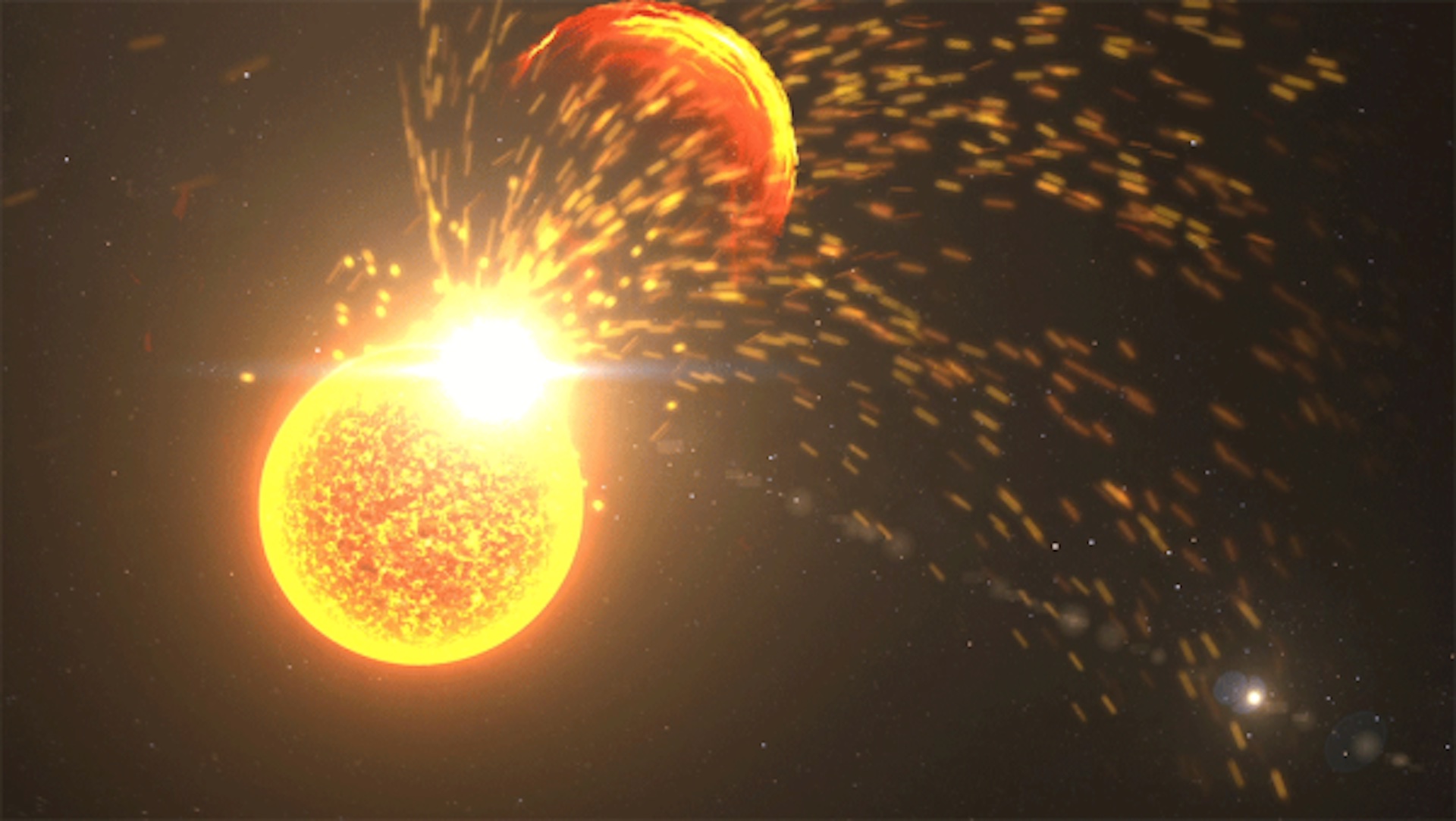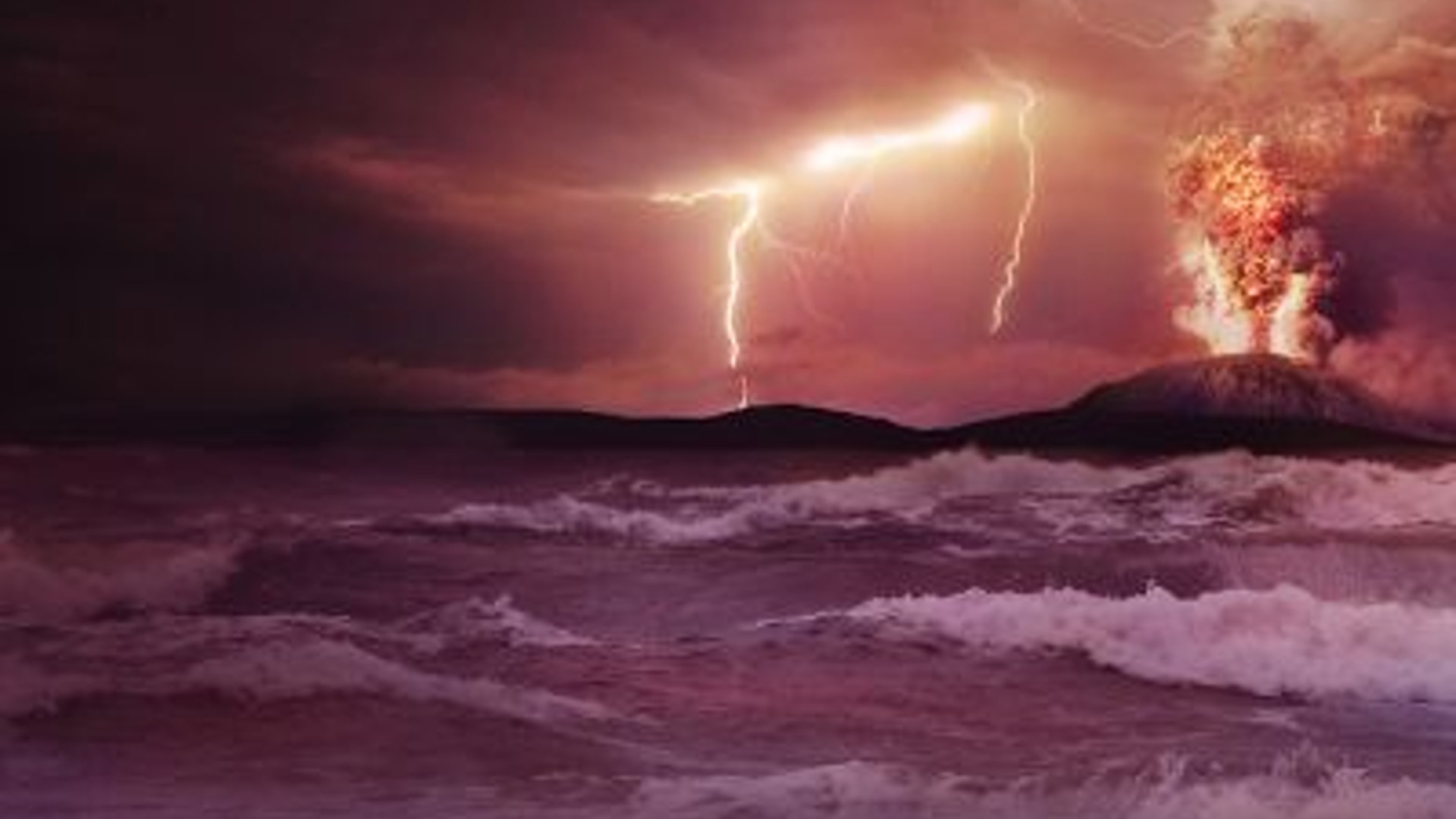Solar 'superflares' millions of times stronger than anything today may have sparked life on Earth
Intense solar storms may have delivered Earth its earliest building blocks of life, new research suggests.

Life on Earth could have been sparked by enormous superflares from a hyperactive young sun, a new study suggests.
By firing charged particles found in the solar wind at a concoction of gases present in Earth's early atmosphere, scientists found that the combined ingredients form significant quantities of amino acids and carboxylic acids — the building blocks for proteins and all organic life.
Scientists have been puzzling over the conditions that sparked life on Earth since the 1800s, when it was speculated that life may have begun in a primordial chemical soup referred to as a "warm little pond." In the 1950s, experiments that exposed gas mixtures of methane, ammonia, water, and molecular hydrogen to artificial lightning showed that 20 different amino acids formed from the process.
Related: See amazing new sun photos from the world's largest solar telescope
In the years since, however, the picture has been complicated. Scientists found that Earth's early atmosphere was filled with less ammonia and methane than previously thought, and more carbon dioxide and molecular nitrogen — both of which are gases that take a lot more energy to break down than lightning alone could provide.
Now, a new study, published April 28 in the journal Life, has used a particle accelerator to find that cosmic rays from fiercely energetic superflares could have provided the necessary jump-start for life on Earth.
"Most investigators ignore galactic cosmic rays because they require specialized equipment, like particle accelerators," lead study author Kensei Kobayashi, a professor of chemistry at Yokohama National University in Japan, said in a statement. "I was fortunate enough to have access to several of them near our facilities."
Get the Space.com Newsletter
Breaking space news, the latest updates on rocket launches, skywatching events and more!

Stars generate powerful magnetic fields, created through the flow of electrical charges in the molten plasma that runs along and beneath their surfaces. On occasion, these magnetic field lines knot into kinks before suddenly snapping, releasing energy in bursts of radiation called solar flares and explosive jets of solar material called coronal mass ejections (CMEs).
When this solar material — primarily consisting of electrons, protons and alpha particles — smashes into Earth's magnetic field, it triggers a geomagnetic storm, agitating molecules in our atmosphere to create colorful auroras known as the northern lights. The largest solar storm in recent history was the 1859 Carrington Event, which released roughly as much energy as 10 billion 1-megaton atomic bombs, but even this event is dwarfed by the power of a superflare, which could be anywhere from hundreds to thousands of times more energetic.
Superflares of this kind typically only erupt once every 100 years or so, but that may not have always been the case. By looking at data from NASA's Kepler mission, which between 2009 and 2018 collected information on Earth-like planets and their stars, a 2016 study in the journal Nature Geoscience showed that, during Earth's first 100 million years the sun was 30% dimmer, yet superflares burst from its surface every three to 10 days.
To see the role superflares could have played in creating amino acids on ancient Earth, the researchers of the new study combined carbon dioxide, molecular nitrogen, water and a varying amount of methane into mixtures of gases they could expect to find in our early atmosphere. Then, by either shooting the gas mixtures with protons from a small particle accelerator (known as a tandem accelerator) or igniting them with simulated lightning, the scientists sparked the production of amino acids and carboxylic acids — both important chemical prerequisites for life.
As the researchers increased the methane levels, the amino acids and carboxylic acids spawned by both the protons and the lightning strikes grew, but to generate them at detectable levels the proton mixture only needed 0.5% methane concentration, whereas the lightning discharges needed 15%.
"And even at 15% methane, the production rate of the amino acids by lightning is a million times less than by protons," said study co-author Vladimir Airapetian, an astrophysicist at NASA’s Goddard Space Flight Center, who also worked on the 2016 Nature Geosciences study. "During cold conditions you never have lightning, and early Earth was under a pretty faint sun. That's not saying that it couldn't have come from lightning, but lightning seems less likely now, and solar particles seem more likely."
Originally published on LiveScience.com.
Join our Space Forums to keep talking space on the latest missions, night sky and more! And if you have a news tip, correction or comment, let us know at: community@space.com.

Ben Turner is a U.K. based staff writer at Live Science. He covers physics and astronomy, among other topics like weird animals and climate change. He graduated from University College London with a degree in particle physics before training as a journalist. When he's not writing, Ben enjoys reading literature, playing the guitar and embarrassing himself with chess.
-
Atlan0001 So it takes heat, lots of heat, to spark, to energize, proto life. Nothing really new there.Reply -
rod "Life on Earth could have been sparked by enormous superflares from a hyperactive young sun, a new study suggests. By firing charged particles found in the solar wind at a concoction of gases present in Earth's early atmosphere, scientists found that the combined ingredients form significant quantities of amino acids and carboxylic acids — the building blocks for proteins and all organic life."Reply
My observations. I find it interesting concerning how abiogenesis experiments are conducted. This experiment used charged particles by firing these particles at a *concoction of gases present in Earth's early atmosphere." Here is another report experimenting with lightning strikes using sparks and early Earth atmosphere but showing problems for early life on Earth to live on nitrogen.
Life on Earth quickly became independent from lightning as a nitrogen source, says new study, https://phys.org/news/2023-05-life-earth-quickly-independent-lightning.html
This experiment and information make it look even harder for abiogenesis to take place and create life, a living cell that uses nitrogen to continue to evolve and change in 3D complexity. There were some experimental conflicts with known geology samples apparently. “However, the isotopic composition the researchers found in their spark experiments does not match that of nitrogen archived in the rock record of early Earth. This discrepancy suggests that lightning was not a major source of nitrogen as microbial life evolved. Instead, these results provide another piece of evidence that microorganisms have been able to convert N2 gas into bioavailable forms for more than three billion years.”
Ref - Isotopic constraints on lightning as a source of fixed nitrogen in Earth’s early biosphere, https://www.nature.com/articles/s41561-023-01187-2, 22-May-2023. “Abstract Bioavailable nitrogen is thought to be a requirement for the origin and sustenance of life. Before the onset of biological nitrogen fixation, abiotic pathways to fix atmospheric N2 must have been prominent to provide bioavailable nitrogen to Earth’s earliest ecosystems. Lightning has been shown to produce fixed nitrogen as nitrite and nitrate in both modern atmospheres dominated by N2 and O2 and atmospheres dominated by N2 and CO2 analogous to the Archaean Earth. However, a better understanding of the isotopic fingerprints of lightning-generated fixed nitrogen is needed to assess the role of this process on early Earth..."
Abiogenesis must create life from non-living matter, no law of biogenesis at work in the beginning, and then later nature must figure out how to allow cells to use nitrogen and not depend upon lightning strikes to feed and grow. Studies like this are important for exoplanet science and astrobiology. -
billslugg Reply
What's new is that lightning has been deposed. Atmosphere was too cool, also not enough methane. Young, dim but energetic solar flares can account for it.Atlan0101 said:So it takes heat, lots of heat, to spark, to energize, proto life. Nothing really new there. -
rod There are other reports too on abiogenesis published by space.com.Reply
What is astrobiology? https://forums.space.com/threads/what-is-astrobiology.59654/
Imagining early Earth as an exoplanet can help us search for alien life, scientists say, https://forums.space.com/threads/imagining-early-earth-as-an-exoplanet-can-help-us-search-for-alien-life-scientists-say.55999/
The first life on Earth depended on a deadly poisonous gas, study suggests, https://forums.space.com/threads/the-first-life-on-earth-depended-on-a-deadly-poisonous-gas-study-suggests.53849/ -
rod My thought. A database should be developed and presented to the public, documenting all of these abiogenesis experiments and evolutionary changes postulated as well as any traps used to eliminate unwanted results. The exoplanet sites are my standard for information tracking on them, the exoplanet.eu site and nasa archive site are well organized IMO. Something akin is needed here I feel for the abiogenesis folks and astrobiology folks attempting to show some type of life, somewhere other than here on Earth and show how life evolves from non-living matter and no law of biogenesis is needed.Reply










